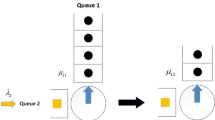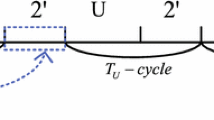Abstract
We analyze a tandem polling queue with two stations operating under three different polling strategies, namely: (1) Independent polling, (2) Synchronous polling, and (3) Out-of-sync polling. Under Markovian assumptions of arrival and service times, we conduct an exact analysis using Matrix Geometric method to determine system throughput, mean queue lengths, and mean waiting times. Through numerical experiments, we compare the performance of the three polling strategies and the effect of buffer sizes on performance. We observe that the independent polling strategy generally performs better than the other strategies, however, under certain settings of product asymmetry, other strategies yield better performance.





Similar content being viewed by others
References
Altman, E., & Yechiali, U. (1994). Polling in a closed network. Probability in the Engineering and Informational Sciences, 8(3), 327–343.
Andradóttir, S., Ayhan, H., & Down, D. G. (2003). Dynamic server allocation for queueing networks with flexible servers. Operations Research, 51(6), 952–968.
Asmussen, S., & Koole, G. (1993). Marked point processes as limits of Markovian arrival streams. Journal of Applied Probability, 30(2), 365–372.
Barron, Y. (2018). Group maintenance policies for an R-out-of-N system with phase-type distribution. Annals of Operations Research, 261(1–2), 79–105.
Barron, Y. (2018). A threshold policy in a Markov-modulated production system with server vacation: The case of continuous and batch supplies. Advances in Applied Probability, 50(4), 1246–1274.
Barron, Y., & Yechiali, U. (2017). Generalized control-limit preventive repair policies for deteriorating cold and warm standby Markovian systems. IISE Transactions, 49(11), 1031–1049.
Bertsimas, D., & Mourtzinou, G. (1999). Decomposition esults for general polling systems and their applications. Queueing Systems, 31(3), 295–316.
Bertsimas, D., & Niño-Mora, J. (1999). Optimization of multiclass queueing networks with Changeover times via the achievable region approach: Part II, the multi-station case. Mathematics of Operations Research, 24(2), 331–361.
Boon, M. A. A. (2012). A polling model with reneging at polling instants. Annals of Operations Research, 198(1), 5–23.
Boon, M. M. A., & Adan, I. J. B. F. (2009). Mixed gated/exhaustive service in a polling model with priorities. Queueing Systems, 63, 383–399.
Boon, M. M. A., Adan, I. J. B. F., & Boxma, O. J. (2010). A two-queue polling model with two priority levels in the first queue. Discrete Event Dynamic Systems, 20(4), 511–536.
Boon, M. M. A., van der Mei, R. D., & Winands, E. M. M. (2011). Applications of Polling Systems. Surveys in operations research and management science, 16(2), 67–82.
Boon, M. A. A., Winands, E. M. M., Adan, I. J. B. F., & van Wijka, A. C. C. (2011). Closed-form waiting time approximations for polling systems. Performance Evaluation, 68(3), 290–306.
Borst, S., Hegde, N., & Proutière, A. (2008). Interacting queues with server selection and coordinated scheduling—Application to cellular data networks. Annals of Operations Research, 170(1), 59–78.
Boxma, O. J., & Groenendijk, W. P. (1987). Pseudo-conservation laws in cyclic-service systems. Journal of Applied Probability, 24(4), 949–964.
Boxma, O. J., Kella, O., & Kosiński, K. M. (2011). Queue lengths and workloads in polling systems. Operations Research Letters, 39(6), 401–405.
Federgruen, A., & Katalan, Z. (1996). Customer waiting-time distributions under base-stock policies in single-facility multi-item production systems. Naval Research Logistics, 43(4), 533–548.
Frigui, I., & Alfa, A. S. (1998). Analysis of a time-limited polling system. Computer Communications, 21(6), 558–571.
Fuhrmann, S. W. (1985). Symmetric queues served in cyclic order. Operations Research Letters, 4(3), 139–144.
Jennings, O. B. (2008). Heavy-traffic limits of queueing networks with polling stations: Brownian motion in a wedge. Mathematics of Operations Research, 33(1), 12–35.
Johnson, M. A., & Taaffe, M. R. (1989). Matching moments to phase distributions: Mixtures of Erlang distributions of common orders. Stochastic Models, 5(4), 711–743.
Khamisy, A., Altman, E., & Sidi, M. (1992). Polling systems with synchronization constraints. Annals of Operations Research, 35(3), 231–267.
Kopzon, A., Nazarathy, Y., & Weiss, G. (2009). A push-pull network with infinite supply of work. Queueing Systems, 62(1–2), 75–111.
Neuts, M. F. (1981). Matrix geometric solution in stochastic models: An algorithmic approach. Baltimore: John Hopkins University Press.
Reiman, M. I., & Wein, L. M. (1999). Heavy traffic analysis of polling systems in tandem. Operations Research, 47(4), 524–534.
Takagi, H. (2000). Analysis and application of polling models. In Performance evaluation: Origins and directions (Vol. 1769, pp. 423–442). Springer, Berlin.
van der Mei, R. D., & Winands, E. M. M. (2008). A note on polling models with renewal arrivals and nonzero switchover times. Operations Research Letters, 36(4), 500–505.
van Vuuren, M., & Winands, E. M. M. (2007). Iterative approximation of \(K\)-limited polling systems. Queueing Systems, 55(161), 161–178.
Vishnevskii, V. M., & Semenova, O. V. (2006). Mathematical methods to study the polling systems. Automation and Remote Control, 67(2), 173–220.
Vlasiou, M., Adan, I. J. B. F., & Boxma, O. J. (2006). A two-station queue with dependent preparation and service times. European Journal of Operations Research, 195(2), 104–116.
Weiss, G., & Kopzon, A. (2002). A push-pull queueing system. Operations Research Letters, 30(6), 351–359.
Winands, E. M. M. (2011). Branching-type polling systems with large setups. OR Spectrum, 33(1), 77–97.
Winands, E. M. M., Adan, I. J. B. F., & van Houtum, G. (2006). Mean value analysis for polling systems. Queueing Systems, 54(35), 35–44.
Author information
Authors and Affiliations
Corresponding author
Additional information
Publisher's Note
Springer Nature remains neutral with regard to jurisdictional claims in published maps and institutional affiliations.
Appendix
Appendix
Matrices for IP strategy
The infinitesimal generator \({\mathbb {Q}}_{IP}\) of the IP strategy defined in Eq. (1) is

The sub-matrices used to describe the transitions of infinitesimal generator \({\mathbb {Q}}_{IP}\) are defined in the Eqs. (20)–(23). Note that we suppress the subscripts corresponding to the strategy for notational simplicity in the submatrices.




where matrices \({\mathbb {S}}_{1}\) and \({\mathbb {S}}_{2}\) are each of dimension \(r \times r\), and are represented by Eqs. (24) and (25) respectively.


Next, we define the diagonal matrices of \({\mathbb {Q}}_{IP}\), namely, \({\mathbb {B}}_{0}\), \({\mathbb {B}}_{1}\), \({\mathbb {B}}_{2}\), \({\mathbb {B}}_{3}\), and \({\mathbb {B}}_{4}\). First, we define \({\mathbb {B}}_{0}\) and \({\mathbb {B}}_{1}\) in Eqs. (26) and (27) respectively.


where matrices \({\mathbb {R}}_{0}\), \({\mathbb {R}}_{1}\), and \({\mathbb {R}}_{2}\) are each of dimensions \(r \times r\) and are represented by Eqs. (28)–(30). In these equations, we set \(\delta _{0} = {} \lambda _{1}+\lambda _{2}+\mu _{12}\), \(\delta _{1} = {} \lambda _{1}+\lambda _{2}+\mu _{11}+\mu _{12}\), and \(\delta _{2} = {} \lambda _{2}+\mu _{11}+\mu _{12}\). The matrix \(\mathbb {S'}_{1}\) is similar to the matrix \({\mathbb {S}}_{1}\) except for that the state transitions are from the states \(\left( l_{11}, l_{21}, 1, *, *, *\right) \) to states \(\left( l_{21}-1, l_{21}, 1, *, *, *\right) \) while the matrix \(\mathbb {R'}_{0}\) have an additional term \(\mu _{11}\) in its diagonal elements when compared to \({\mathbb {R}}_{0}\). The matrix \({\mathbb {B}}_{2}\) is same as matrix \({\mathbb {B}}_{1}\) except that \(\lambda _{2}\) is 0 in \(\mathbb {R'}_{0}\) , \({\mathbb {R}}_{1}\), and \({\mathbb {R}}_{2}\). Other diagonal matrices \({\mathbb {B}}_{3}\) and \({\mathbb {B}}_{4}\) in the infinitesimal generator can obtained similarly.



Matrices for SP strategy
The infinitesimal generator of the SP strategy \({\mathbb {Q}}_{SP}\) defined in Eq. (2) is

The dimensions of all the matrices used in \(\displaystyle \mathop {{\mathbb {Q}}_{SP}}\) are summarized in Table 7. The matrices \({\mathbb {A}}_{1}\), \(\mathbb {A'}_{1}\), \({\mathbb {A}}_{2}\), \({\mathbb {A}}_{2}^{'}\), \({\mathbb {D}}_{11, k}\), and \({\mathbb {D}}_{21, k}\) in \({\mathbb {Q}}_{SP}\) are similar to the respective matrices in \({\mathbb {Q}}_{IP}\), and can be obtained using the Eqs. (20)–(23). Next, we define the diagonal matrices of \({\mathbb {Q}}_{SP}\), namely, \({\mathbb {B}}_{0}\), \({\mathbb {B}}_{1}\), \({\mathbb {B}}_{2}\), \({\mathbb {B}}_{3}\), and \({\mathbb {B}}_{4}\). First, we define \({\mathbb {B}}_{0}\) in Eq. (32).

where matrices \({\mathbb {R}}_{0}\), \({\mathbb {R}}_{1}\), and \({\mathbb {R}}_{2}\) are represented by Equations (33) – (35). In these equations, we set \(\delta _{0} = {} \lambda _{1}+\lambda _{2}+\mu _{12}\), \(\delta _{1} = {} \lambda _{1}+\lambda _{2}+\mu _{11}+\mu _{12}\), and \(\delta _{2} = {} \lambda _{2}+\mu _{11}+\mu _{12}\). The submatrix \(\mathbb {S'}_{1}\) can be obtained using Equation (24).



Other diagonal matrices \({\mathbb {B}}_{1}\), \({\mathbb {B}}_{2}\), \({\mathbb {B}}_{3}\), and \({\mathbb {B}}_{4}\) in the infinitesimal generator can obtained similarly. Lastly, we define \({\mathbb {X}}_{1}\) and \({\mathbb {X}}_{2}\) in Eqs. (36) and (37).


Matrices for OP strategy
The infinitesimal generator of the OP strategy \({\mathbb {Q}}_{OP}\) defined in Eq. (3) is

The dimensions of all the matrices used in \(\displaystyle \mathop {{\mathbb {Q}}_{OP}}\) are summarized in Table 8. The matrices \({\mathbb {A}}_{1}\), \(\mathbb {A'}_{1}\), \({\mathbb {A}}_{2}\), \({\mathbb {A}}_{2}^{'}\), \({\mathbb {D}}_{11, k}\), and \({\mathbb {D}}_{21, k}\) in \({\mathbb {Q}}_{OP}\) are similar to the respective matrices in \({\mathbb {Q}}_{IP}\), and can be obtained using the Eqs. (20)–(23). Next, we define the diagonal matrices of \({\mathbb {Q}}_{OP}\), namely, \({\mathbb {B}}_{0}\), \({\mathbb {B}}_{1}\), \({\mathbb {B}}_{2}\), \({\mathbb {B}}_{3}\), and \({\mathbb {B}}_{4}\). First, we define \({\mathbb {B}}_{0}\) in Eq. (38).

Next, we define one of the submatrix, \(\displaystyle \mathop {{\mathbb {R}}_{0}}\) of matrix \(\displaystyle \mathop {{\mathbb {B}}_{0}}\) in the Eq. (39). In this equation, we set \(\delta _{0} = {} \lambda _{1}+\lambda _{2}+\mu _{22}\).

Similarly, we can define the other diagonal submatrices \({\mathbb {R}}_{1}\) and \({\mathbb {R}}_{2}\) of matrix \(\displaystyle \mathop {{\mathbb {B}}_{0}}\). The submatrix \(\mathbb {S'}_{1}\) can be obtained using the approach in Eq. (24). Other diagonal matrices \({\mathbb {B}}_{1}\), \({\mathbb {B}}_{2}\), \({\mathbb {B}}_{3}\), and \({\mathbb {B}}_{4}\) in the infinitesimal generator can obtained similarly. Lastly, we define \({\mathbb {X}}_{1}\) and \({\mathbb {X}}_{2}\) for OP strategy in Eqs. (40) and (41).


Rights and permissions
About this article
Cite this article
Suman, R., Krishnamurthy, A. Analysis of tandem polling queues with finite buffers. Ann Oper Res 293, 343–369 (2020). https://doi.org/10.1007/s10479-019-03358-0
Published:
Issue Date:
DOI: https://doi.org/10.1007/s10479-019-03358-0




